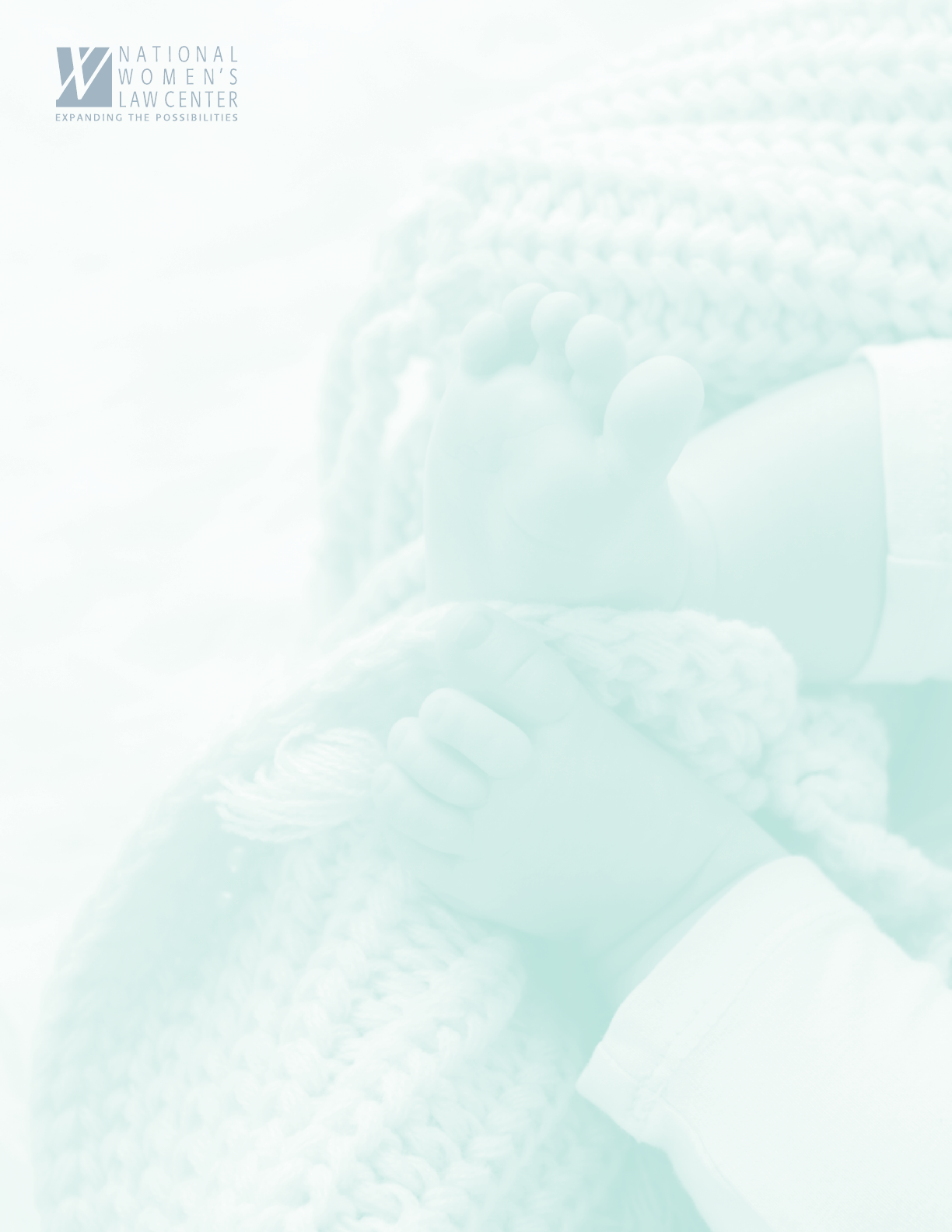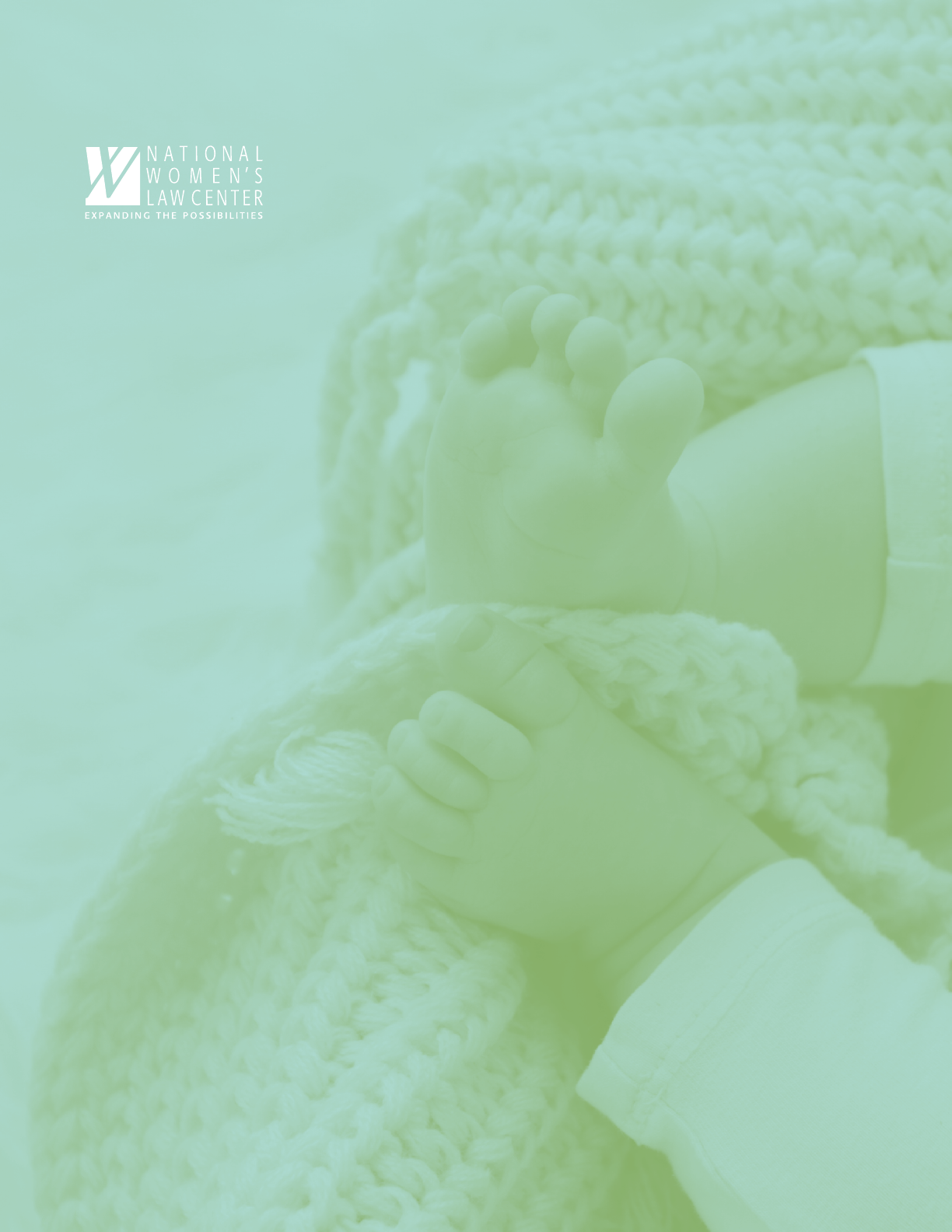
EXPANDING THE POSSIBILITIES
state of breastfeeding
coverage: health plan
violations of the affordable care act

© 2015 National Women’s Law Center
ABOUT THE CENTER
The National Women’s Law Center is a
non-prot organization that has been working
since 1972 to advance and protect women’s
equality and opportunity. The Center focuses
on major policy areas of importance to
women and their families, including economic
security, education, employment and health,
with special attention given to the concerns
of low-income women.
For more information about the Center or to
make a tax-deductible contribution to support
the Center’s work, please visit: www.nwlc.org
or call the Development ofce at
202-588-5180.
ACKNOWLEDGMENTS
The report was a collaborative endeavor
that relied upon the work of many individuals.
The primary author of the report was
Anna Benyo, with assistance from Karen
Davenport and Gretchen Borchelt.
Beth Stover designed the report.
DISCLAIMER
While text and citations are, to the best
of the authors’ knowledge, current as
this report was prepared, there may be
subsequent developments—including
changes to the plan documents or new
administrative guidance—that could alter
the information provided herein.
This report does not consist of an
exhaustive list of violations in health plans
and is not meant to be used to inform
consumers about their personal health
coverage. In addition, this report does not
constitute legal advice; individuals and
organizations considering legal action should
consult with their own legal counsel before
deciding on a course of action.

state of
breastfeeding
coverage:
health plan violations
of the affordable
care act
May 2015
Introduction .................................................................... 1
The Affordable Care Act’s coverage of breastfeeding
support and supplies ...................................................... 3
Affordable Care Act requirements .................................. 4
Insurance plans must cover breastfeeding
support and supplies, for the duration of
breastfeeding .......................................................... 4
Insurance plans must provide access to
out-of-network providers at no cost-sharing ........... 4
Insurance companies may use limited
“reasonable medical management”........................ 4
Insurance companies can limit coverage
to a manual pump ................................................... 4
Coverage problems that prevent women from
getting breastfeeding benets ........................................ 5
Insurance companies impose unallowable
limitations on breastfeeding support and
supplies ................................................................... 5
Insurance companies have not established
a network of providers and are not following
federal rules allowing women to obtain services
out-of-network, at no cost-sharing .......................... 6
Insurance companies impose major
administrative barriers ............................................ 7
Federal guidance allowing coverage
of only manual pumps is insufcient ...................... 8
Recommendations ......................................................... 9
Conclusion ....................................................................11
Table
of Contents
NatioNal WomeN’s laW CeNter
STATE OF BREASTFEEDING COVERAGE: HEALTH PLAN VIOLATIONS OF THE AFFORDABLE CARE ACT 1
Introduction
THE AFFORDABLE CARE ACT’S (ACA) COVERAGE
OF BREASTFEEDING EQUIPMENT, SUPPORT, AND
COUNSELING IS A GROUNDBREAKING NEW
INSURANCE BENEFIT.
In order to support women’s
efforts to breastfeed, and reduce cost barriers for women
who want to breastfeed, the ACA requires insurance
coverage of breastfeeding supplies, support, and
counseling without co-payments, deductibles, or
co-insurance.
1
This coverage is an important step to
ensure women have the support and tools they need
to breastfeed successfully.
However, some women do not fully benet from this new
coverage. In some cases, insurance policies fail to comply
with the ACA’s breastfeeding coverage requirements, or
restrict coverage in ways that undermine the intent of the
law.
2
In other instances, the federal guidance detailing
coverage standards falls short of what women need to
breastfeed successfully. Insurance plan noncompliance—
and the lack of clear federal standards and inadequate
guidance—means that women are not getting insurance
coverage that meets their needs.
The National Women’s Law Center (the Center) operates
a nationwide hotline, CoverHer, which women can call
when they face problems accessing the breastfeeding
benets to which they are entitled. Through this hotline,
the Center has heard from women across the country.
Women who contact the Center report spending hours on
the phone with their insurance company trying to decipher
what their insurance plan covers, and how they can get
breastfeeding benets as soon as possible. But, customer
service representatives frequently give them conicting
information about their coverage, or wrongly tell them
their plan does not provide coverage of breastfeeding
support. Some women pay hundreds of dollars out-of-
pocket for services; other women who cannot afford to
pay the full cost of services forgo getting breastfeeding
help altogether.
In addition to reports received through CoverHer, the Center
reviewed over 100 plan documents from issuers in the
new marketplaces in 15 states.
3
This research, combined
with stories from the hotline, points to three major trends
that prevent women from getting breastfeeding benets as
required by law:
• Some insurance companies impose restrictions and
limitations on breastfeeding support and supplies that
explicitly violate the ACA or undermine the intent of
the law;
• Some insurance companies do not have a network of
lactation providers and are not following clear federal
rules that allow women to obtain preventive services,
including breastfeeding benets, out-of-network, at
no cost-sharing; and
• Some insurance companies impose major administrative
barriers or offer insufcient coverage that prevents women
from obtaining timely breastfeeding support and adequate
equipment, as the ACA intended.
In addition to these three major trends, research and
CoverHer contacts have reported other problems with the
implementation of the ACA’s breastfeeding benet, such
as plans limiting coverage to a manual pump, which is
permitted by federal guidance but is a huge barrier to some
women breastfeeding successfully.
This report highlights the obstacles women face when
trying to get coverage for breastfeeding benets and
identies strategies to remedy violations of the law and to
revisit the insufcient federal guidance that leaves women
without the coverage they need. To that end, the Center’s
recommendations call for insurance companies to come
into compliance and correct any violations of the ACA. The
recommendations also call for state and federal regulators
to carefully review coverage policies and promptly respond
to consumer complaints. And in order to ensure that federal
NatioNal WomeN’s laW CeNter
2 STATE OF BREASTFEEDING COVERAGE: HEALTH PLAN VIOLATIONS OF THE AFFORDABLE CARE ACT
guidance itself does not permit insurance company
policies that leave women with inadequate breastfeeding
coverage, the recommendations call for the Departments
of Health and Human Services, Treasury, and Labor
(the Departments) to engage a range of stakeholders
to reexamine coverage standards and develop new
guidance that ensures women across the country get the
tools they need to breastfeed successfully.
NatioNal WomeN’s laW CeNter
STATE OF BREASTFEEDING COVERAGE: HEALTH PLAN VIOLATIONS OF THE AFFORDABLE CARE ACT 3
The Affordable Care Act’s
coverage of breastfeeding
support and supplies
THE ACA’S BREASTFEEDING BENEFITS ARE PART OF
THE LAW’S PREVENTIVE HEALTH SERVICES COVERAGE
PROVISION,
which is designed to enable individuals to
avoid preventable conditions and improve health overall
by increasing access to preventive care and screenings.
This provision requires health insurance plans to
provide coverage for certain preventive services
without out-of-pocket costs, including a set of
preventive services for women.
To determine which women’s preventive services
would be covered without out-of-pocket costs, the
Health Resources Services Administration (HRSA)
of the Department of Health and Human Services
commissioned the Institute of Medicine (IOM) to study
gaps in coverage of women’s preventive services and
to recommend which additional women’s preventive
services should be included. After conducting its
analysis, the IOM recommended eight additional
preventive services for women, including breastfeeding
support and supplies. HRSA adopted the recommenda-
tions set forth in the IOM’s report.
4
According to the
HRSA requirement, coverage is for comprehensive
lactation support and counseling, including the costs
of breastfeeding equipment, to ensure the successful
initiation and continuation of breastfeeding.
The reason the IOM recommended adding coverage for
breastfeeding support and supplies is because research
has consistently shown that breastfeeding benets
the mother and the child. According to the Agency for
Healthcare Research and Quality (AHRQ), breastfeeding
reduces children’s risk for a variety of common childhood
illnesses and less frequent but serious conditions,
including sudden infant death syndrome, ear infections,
upper and lower respiratory disease, asthma, childhood
leukemia, childhood obesity, and Type 2 diabetes.
5
It also
reduces maternal risk for breast and ovarian cancer.
6
Based on this and other research, the American College
of Obstetricians and Gynecologists and the American
Academy of Pediatrics support exclusive breastfeeding
for approximately six months, with continuation of
breastfeeding, if possible, even longer.
7
Despite the proven benets of breastfeeding, there is a gap
between women’s decision to breastfeed their children and
the support they need to successfully breastfeed for as
long as intended. A majority of pregnant women plan to
breastfeed and initiate breastfeeding at birth, but a much
lower proportion of women continue to breastfeed. One
study found that 76 percent of new mothers began
breastfeeding, with 47 percent continuing to breastfeed at
6 months, and only 26 percent breastfeeding at 12 months.
8
While breastfeeding rates have been growing steadily,
there are signicant gaps across racial, ethnic, and
socioeconomic lines.
9
The Surgeon General’s Call to Action to Support
Breastfeeding outlines several key barriers women face
when breastfeeding. The report indicates that successful
initiation of breastfeeding not only depends on experiences
in the hospital but also depends on access to instruction
on lactation from breastfeeding experts, particularly in the
postpartum period.
10
NatioNal WomeN’s laW CeNter
4 STATE OF BREASTFEEDING COVERAGE: HEALTH PLAN VIOLATIONS OF THE AFFORDABLE CARE ACT
Affordable Care Act
requirements
THE ACA REQUIRES HEALTH PLANS TO COVER
BREASTFEEDING SUPPORT AND SUPPLIES WITHOUT
CO-PAYMENTS, DEDUCTIBLES, OR CO-INSURANCE,
FOR THE DURATION OF BREASTFEEDING.
11
The ACA
requires this coverage for most employer health insurance
plans, individual health coverage purchased on insurance
Marketplaces operating in each state, and Medicaid
enrollees who are newly eligible as part of a state’s
decision to adopt the ACA’s Medicaid expansion.
12
INSURANCE PLANS MUST COVER BREASTFEEDING
SUPPORT AND SUPPLIES, FOR THE DURATION OF
BREASTFEEDING
According to the HRSA recommendations, insurance
plans must cover comprehensive lactation support
and counseling by a trained provider, and costs of
breastfeeding equipment. This requirement applies in
conjunction with each birth. Federal guidance species
that coverage for breastfeeding support and supplies
extends for the duration of breastfeeding.
13
This means
that plans cannot impose time limits on when women can
obtain lactation counseling and breastfeeding equipment.
INSURANCE PLANS MUST PROVIDE ACCESS TO
OUT-OF-NETWORK PROVIDERS AT NO COST-SHARING
Federal guidance species that women must be able
to obtain recommended preventive services with no
cost-sharing, and, in some circumstances, obtain these
services from out-of-network providers. Specically, the
guidance states, “if a plan or issuer does not have not
have in its network a provider who can provide the
particular service, then the plan or issuer must cover the
item or service when performed by an out-of-network
provider and not impose cost-sharing with respect to the
item or service” (emphasis added).
14
This means that if an
insurance company does not have a network of providers
for women to receive lactation counseling, then the plan
must allow them to obtain lactation counseling from an
out-of-network provider, at no cost-sharing.
INSURANCE COMPANIES MAY USE LIMITED
“REASONABLE MEDICAL MANAGEMENT”
Under the regulations implementing the preventive
health services, insurance companies are allowed to use
“reasonable medical management techniques” to determine
the “frequency, method, treatment, or setting for which a
recommended preventive service will be available without
cost-sharing requirements to the extent not specied in
a recommendation or guideline.”
15
But these medical
management techniques are not unlimited. While plans
may use reasonable medical management techniques,
they cannot limit or restrict coverage in ways that conict
with federal guidance. For example, because coverage
of breastfeeding benets extends for the duration of
breastfeeding, plans cannot impose an arbitrary time
limit on when women can access these benets.
INSURANCE COMPANIES CAN LIMIT COVERAGE
TO A MANUAL PUMP
Unfortunately, the Department of Health and Human
Services has claried that the ACA does not require
insurance plans to cover a certain type of pump.
16
However, a manual pump is insufcient for many
women such as women returning to work, women
who have preterm or ill infants, low milk supply,
or women who have physical disabilities.
17
NatioNal WomeN’s laW CeNter
STATE OF BREASTFEEDING COVERAGE: HEALTH PLAN VIOLATIONS OF THE AFFORDABLE CARE ACT 5
Coverage problems that
prevent women from getting
breastfeeding benets
UNFORTUNATELY, NOT EVERY WOMAN WHO SHOULD BE
GETTING COVERAGE OF BREASTFEEDING SUPPORT AND
SUPPLIES WITHOUT COST-SHARING HAS BEEN ABLE TO
ACCESS THIS IMPORTANT BENEFIT.
The Center has
documented this through the review of coverage policies
in 15 states’ marketplaces. In addition, the Center
receives calls and emails through a nationwide hotline
from women who face signicant barriers to getting
coverage to which they are entitled under the ACA.
The Center has identied three major trends that prevent
women from getting breastfeeding benets:
• Some insurance companies impose restrictions and
limitations on breastfeeding support and supplies, which
explicitly violate the ACA or undermine the intent of
the law;
• Some insurance companies do not have a network of
providers for women to get lactation counseling and
are not following clear federal rules that allow women
to obtain preventive services, including breastfeeding
benets, out-of-network, at no cost-sharing; and
• Some insurance companies impose major
administrative barriers or offer insufcient coverage
that prevents women from obtaining timely
breastfeeding support and adequate equipment,
as envisioned by the ACA.
INSURANCE COMPANIES IMPOSE UNALLOWABLE
LIMITATIONS ON BREASTFEEDING SUPPORT AND
SUPPLIES
Insurance companies have coverage policies for
breastfeeding that are more limited than federal guidance
allows. Women who have contacted the Center report
that they had to obtain a breast pump within 6 months
after their baby was born. In some cases, women report the
insurance company only covers a breast pump 48 days after
delivery.
In addition to reports from women trying to use this
benet, the Center’s plan document research found similar
restrictions. Three health issuers in two states only allow
women to obtain a breast pump within 6 months of
delivery.
18
Two issuers in one state limit rental of a breast
pump to 12 months.
19
Two issuers in two states indicate the
plan determines the duration of rental.
20
One issuer limits
coverage of a breast pump to one purchase every three
years.
21
All of these restrictions are clear violations of the
ACA’s requirement to provide coverage for the duration
of breastfeeding.
22
Many women need access to breast pumps to maintain
their milk supply, particularly when returning to work. In
fact, one of the reasons the IOM recommended coverage
of breastfeeding equipment was to ensure that women who
return to work or have other obligations that separate them
from their infant can continue to breastfeed, if they choose
to, without cost barriers.
23
Several hotline callers report similar limitations on
breastfeeding support and lactation counseling. Women
report that their insurance plan will only provide coverage
for lactation counseling on an inpatient basis during the
post-delivery hospital stay. If they are already home and
having problems breastfeeding, their insurance plan says
that lactation counseling is not covered.
In addition to reports from women facing barriers in
accessing lactation counseling, the Center’s plan document
research found similar restrictions in lactation counseling.
Six health insurance issuers in one state only allow women

NatioNal WomeN’s laW CeNter
6 STATE OF BREASTFEEDING COVERAGE: HEALTH PLAN VIOLATIONS OF THE AFFORDABLE CARE ACT
to get lactation services within two months of
delivery.
24
Three issuers in one state limit coverage to
a single lactation visit within two months of delivery.
25
One company limits breastfeeding education to one visit
per pregnancy.
26
Another company limits breastfeeding
education to two services per calendar year (for pregnant
women) and three counseling sessions in conjunction with
each birth.
27
All of these examples conict with federal
guidance requiring insurance companies to cover
breastfeeding equipment and support, in conjunction
with each birth, for the duration of breastfeeding.
28
Some women need intensive lactation support to
manage initial breastfeeding challenges such as
insufcient milk supply or a newborn’s difculty latching.
Sometimes a woman will need lactation support after
breastfeeding has been established, if she encounters
medical issues associated with breastfeeding, such as
thrush or mastitis that affect her ability to breastfeed. Even
after breastfeeding is well-established, some women who
return to work experience problems with their milk supply
and may need additional lactation counseling to continue
breastfeeding.
The HRSA guidelines recognize the various points
at which women may need lactation support and
breastfeeding equipment, and specically recommend
that benets should encompass the initiation and
duration of breastfeeding. In all of these examples,
insurance companies are imposing benet limits and
restrictions that violate the law.
INSURANCE COMPANIES HAVE NOT ESTABLISHED A
NETWORK OF PROVIDERS AND ARE NOT FOLLOWING
FEDERAL RULES ALLOWING WOMEN TO OBTAIN
SERVICES OUT-OF-NETWORK, AT NO COST-SHARING
Despite the ACA’s requirement to provide “comprehensive
lactation support,” insurance companies have not
established networks of lactation providers.
29
In these
instances, the plan typically refers women to their
obstetrician or to the child’s pediatrician—neither of
whom usually offers lactation counseling. In some cases,
women report that insurance companies have one
in-network lactation provider (usually located in a hospital)
to serve all of the plan’s enrollees. And in the case of
hospital-based lactation consultants, hospital policy often
restricts these providers to in-patient clients, which means
women cannot access these health professionals once
they are discharged from the hospital.
The lack of a provider network for lactation counseling
means that women must turn to out-of-network providers to
get help with breastfeeding. Federal guidance clearly allows
women to obtain required preventive services, including
breastfeeding benets, through out-of-network providers, at
no cost-sharing, when the plan does not maintain a network
of appropriate providers.
30
However, dozens of women have
contacted the Center to report their insurance company is
ignoring this rule and denying payment for services they
obtained out-of-network. These denials violate the ACA.
IN THEIr OwN wOrDS: DENIED COvErAGE Of A BrEAST PumP
“I was going back to work and wanted to use a breast pump. My insurance company told me that I wasn’t eligible for
a breast pump because it had been over 180 days since I gave birth. I contacted the Center to see if this policy was
correct. The Center helped me le a claim and later an appeal with my insurance company. Many months later
they reimbursed me $200 for a breast pump. The whole ordeal was such a hassle.”
—Nicole, California

NatioNal WomeN’s laW CeNter
STATE OF BREASTFEEDING COVERAGE: HEALTH PLAN VIOLATIONS OF THE AFFORDABLE CARE ACT 7
When plans fail to establish a network of providers,
women face signicant barriers to accessing
breastfeeding benets that should be covered by law.
Women have to pay at the point of service for lactation
counseling, and seek reimbursement from their plan
afterwards. Plans often deny these claims because the
woman obtained benets out-of-network. Upon appeal,
some plans will partially reimburse the cost of lactation
counseling—but they reimburse at the out-of-network
rate which means women still pay signicant money for
services that should have been fully covered. Women
report that some plans deny the claim altogether because
they did not follow a lengthy and time-consuming
IN THEIr OwN wOrDS:
DENIED COvErAGE Of
LACTATION COuNSELING
“My daughter was only a few days old, and had
been so dehydrated at the hospital (due to
breastfeeding issues) that they almost put her in
the NICU. I needed to see a lactation specialist
immediately, but my insurance company didn’t have
any lactation providers in their directory. So I called
my insurance company to nd out if I could get
coverage. They told me that their in-network provider
was La Leche League and gave me the names and
numbers of two women who run a local La Leche
League meeting. But when I contacted these
women, they explained that La Leche League is
a breastfeeding support group, not a provider
network! I ultimately saw a certied lactation
consultant on my own, which solved my
breastfeeding problems. Now I’m trying to get
reimbursed. I’ve been ghting with my insurance
company since July 2014 and I’m still trying to
get reimbursed!”
—Alysson, Washington DC
administrative process to get approval from the plan
to access out-of-network providers.
31
These practices
effectively shift more costs to women. Some women—
especially women with limited income or who may be taking
unpaid family leave—will not be able to pay the full cost of
lactation counseling at the point of service, and will not get
the care they need. For these women, they effectively have
no benet at all.
IN THEIr OwN wOrDS:
DENIED COvErAGE AND
CAN’T AffOrD SErvICES
“I’m currently ghting with my insurance company
to reimburse me for lactation counseling that I got
right after my son was born. I tried to go in-network
but the plan didn’t have any in-network lactation
consultants. I’ve already spent $375 dollars. I’d
like to see a lactation consultant again because
I’m still having breastfeeding problems. I’m three
weeks post-partum and feel like I’m running out
of time to establish breastfeeding. But, the visits
are so expensive and I’m not sure how much more
I can spend out-of-pocket, especially while I’m on
maternity leave.”
—A Woman in Virginia
INSURANCE COMPANIES IMPOSE MAJOR
ADMINISTRATIVE BARRIERS
Insurance companies impose administrative barriers
that hamper women’s ability to get timely breastfeeding
benets. These barriers include medical management
techniques like prior authorization and restrictions on
when women can get services. For example, women
report that some insurance companies will not provide
coverage of a breast pump until after the baby is born and
only after going through some administrative barriers such
as getting a prescription or prior authorization.

NatioNal WomeN’s laW CeNter
8 STATE OF BREASTFEEDING COVERAGE: HEALTH PLAN VIOLATIONS OF THE AFFORDABLE CARE ACT
Women in these plans will not get their breast pumps until
a few weeks after they give birth. This coverage policy
is problematic because some women need a breast
pump immediately. The newborn could be unable to latch
properly, or need intensive medical services that require
them to be admitted into the Neonatal Intensive Care Unit
(NICU). Premature babies or newborns with other health
challenges may have difculty feeding and women will
need to begin using a breast pump immediately to
establish their milk supply.
In other instances, some women who previously faced
breastfeeding challenges and are having subsequent
children may already know they need to use a breast
pump shortly after giving birth to help build their milk
supply. Coverage policies that limit when a woman can
get a breast pump can interfere with her attempts to
initiate breastfeeding. Further, the IOM’s recommendation
is for comprehensive support “in conjunction with each
birth.” Nothing in the ACA or federal guidance indicates
that the coverage only begins after delivery.
FEDERAL GUIDANCE ALLOWING COVERAGE OF
ONLY MANUAL PUMPS IS INSUFFICIENT
Unfortunately, the Department of Health and Human
Services indicates that, under the ACA, insurance plans
are not required to cover a certain type of pump.
32
For example, some plans only provide coverage of a manual
pump and exclude all electronic or hospital grade pumps.
Limiting coverage to a manual pump means that some
women will not get access to the tools they need to
successfully breastfeed.
Women need access to hospital grade pumps for various
reasons. Women who have newborns in the NICU and are
separated from their infant cannot initiate breastfeeding with
a manual pump. Women in these circumstances will require
an electric or hospital grade pump to establish their milk
supply.
33
The American Academy of Pediatrics (AAP)
strongly encourages feeding infants who are in the
NICU human milk.
34
Further, AAP recommends that breast pump coverage
include all grades of breast pumps (manual, electric,
hospital grade), indicating that “[m]anual breast pumps may
not be appropriate in all situations and benet plans should
include coverage for electric and hospital grade breast
pumps. Double electric or hospital grade pumps are often
more efcient to maintain milk supply for mothers that return
to work.”
35
In addition, women returning to work may nd a
manual pump incompatible with their need to express milk
quickly and efciently during the work day.
IN THEIr OwN wOrDS: wOmEN NEED BETTEr COvErAGE
Debbie is a Clinical Nurse Specialist and International Board Certied Lactation Consultant. In her level 4 NICU, she
works with new mothers who are separated from their infants and require a hospital grade breast pump to establish
their milk supplies and feed their babies.
“Providing a manual or consumer level pump to a mother who has a newborn in the NICU is totally insufcient. These
mothers need a hospital grade pump, and lots of lactation support.”
—Debbie, Clinical Nurse III/IBCLC

NatioNal WomeN’s laW CeNter
STATE OF BREASTFEEDING COVERAGE: HEALTH PLAN VIOLATIONS OF THE AFFORDABLE CARE ACT 9
Recommendations
THE ACA’S BREASTFEEDING BENEFITS ARE A HUGE
STEP FORWARD
that can remove the cost barriers
associated with breastfeeding support and equipment
and give women the tools they need to successfully
breastfeed for as long as they want. However, because
insurance companies are not following the law, women
are not getting breastfeeding benets as required by
the ACA. To make certain that every woman gets the
coverage guaranteed to her under the ACA, insurance
companies and state and federal governments must take
steps to ensure plans comply with the law.
INSURANCE COMPANIES: BRING COVERAGE
INTO COMPLIANCE
Insurance companies must carefully examine
coverage documents to ensure the policy
complies with federal regulation and guidance. Plans
should immediately remove restrictions or limitations
that violate the ACA.
Insurance companies must—at a minimum—
establish a network of lactation providers so
women can obtain timely in-network lactation services
with no cost-sharing or up-front costs, within a
reasonable distance. As plans build this network,
however, they must allow women to obtain services
from out-of-network providers, at no cost-sharing, as
required by law.
Insurance companies must remove all
administrative barriers to getting timely lactation
support. Women should not be required to pay the full
costs of lactation counseling out-of-pocket and then
seek reimbursement through a series of claims and
appeals.
Insurance companies must remove all
administrative barriers to getting a breast pump.
Insurance companies should permit women to obtain
breast pumps prior to delivery. They should also have an
expedited process so that women can acquire a breast
pump quickly when they need it.
FEDERAL AND STATE REGULATORS: ENFORCE THE LAW
Federal regulators must ensure plans comply with the
ACA’s breastfeeding benets and enforce the law. It
is inexcusable to expect women to pay the full costs of
lactation services, up-front, with no guarantee the costs
will be fully reimbursed, as required by law. It is also
inexcusable to allow insurance companies to circumvent
reasonable network requirements.
State regulators must ensure health insurance
complies with the ACA, its implementing regulations,
and related guidance. Most states are responsible for
the initial certication of health plans on state and federal
Marketplaces. State regulators must be diligent in their
review of Qualied Health Plan documents and
determined in their efforts to bring plans into compliance
with the law during the certication process.
State regulators must be diligent about responding
to complaints about coverage violations. State
regulators must respond to complaints from women
about insurance practices that create administrative
barriers to required coverage. Regulators should pay
particular attention to complaints of an insufcient
network for lactation counseling.
State regulators should inform women about the
law and its coverage requirements for women’s health.
For example, states should work with stakeholders to
develop and distribute informational bulletins on the
ACA’s preventive services requirements and the scope
of breastfeeding coverage. Women need this information
to be informed consumers and to advocate for the
coverage they need.

NatioNal WomeN’s laW CeNter
10 STATE OF BREASTFEEDING COVERAGE: HEALTH PLAN VIOLATIONS OF THE AFFORDABLE CARE ACT
State regulators should broadly publicize the
appeals process. Women need to know the
appropriate course of action when plans fail to
provide the coverage the ACA requires, and plans
need to be held accountable when they do not
comply with the law.
Compliance with the existing law is not enough. To
fulll the promise of this benet, policymakers need to
reexamine what coverage should encompass, and should
more closely align coverage requirements with the IOM’s
recommendations and input from a range of important
stakeholders
THE DEPARTMENTS OF HEALTH AND HUMAN
SERVICES, TREASURY, AND LABOR: REVISIT
GUIDANCE AND ENGAGE STAKEHOLDERS
The Departments should revisit current guidance
to ensure coverage of breastfeeding support and
supplies aligns with the Institute of Medicine’s
recommendations and best practices.
The Departments should engage
stakeholders—breastfeeding experts, the
medical community, advocates, and insurance
companies—to develop new federal standards
for breastfeeding coverage that takes into account
the best evidence.
NatioNal WomeN’s laW CeNter
STATE OF BREASTFEEDING COVERAGE: HEALTH PLAN VIOLATIONS OF THE AFFORDABLE CARE ACT 11
Conclusion
THE ACA’S INVESTMENT IN PREVENTIVE SERVICES
AND BREASTFEEDING BENEFITS IS A HISTORIC STEP
FORWARD.
Access to breastfeeding equipment and
the expertise of trained lactation providers is critical to
removing barriers to breastfeeding. Millions of women
across the country are already benetting from the law,
in terms of both their health and the impact it has on
their families and lives. But, there is signicant room for
improvement—right now, women do not have access to
coverage required by law and face inexcusable barriers
to getting breastfeeding benets. All stakeholders must
work together to correct these problems and ensure that
breastfeeding benets fulll the promise of the ACA.

NatioNal WomeN’s laW CeNter
12 STATE OF BREASTFEEDING COVERAGE: HEALTH PLAN VIOLATIONS OF THE AFFORDABLE CARE ACT
1 TheAffordableCareActdenes“cost-sharing”toinclude“deductibles,coinsurance,copayments,orsimilarcharges.”
(42U.S.C.§18022(c)(3)(A)(i).)
2 Thisreportusestheterm“insurancecompanies”throughouttorefertobothgroupandindividualhealthplans.
3 Theanalysisencompassesmorethan100publiclyavailablecerticatesofcoverageforQualiedHealthPlansofferedin2014
and/or2015fromAlabama,California,Colorado,Connecticut,Florida,Maine,Maryland,Minnesota,Nevada,Ohio,Rhode
Island,SouthDakota,Tennessee,Washington,andWisconsin.
4 U.S.Dep’tofHealthandHumanSrvcs.,HealthRes.andSrvcs.Admin.,Women’s Preventive Services Guidelines(Aug.1,2011),
Accessedathttp://www.hrsa.gov/womensguidelines/
5 IpS,ChungM,RamanG,ChewP,MagulaN,DeVineD,TrikalinosT,LauJ.BreastfeedingandMaternalandInfantHealth
OutcomesinDevelopedCountries.EvidenceReport/TechnologyAssessmentNo.153(PreparedbyTufts-NewEnglandMedical
CenterEvidence-basedPracticeCenter,underContractNo.290-02-0022).AHRQPublicationNo.07-E007.Rockville,MD:
AgencyforHealthcareResearchandQuality.April2007.
6 Ibid.
7 InstituteofMedicine,“ClinicalPreventiveServicesforWomen:ClosingtheGaps,”(2011),theNationalAcademiesPress.
8 CDCNationalImmunizationSurveys2012and2013,Data,2011births.Accessedathttp://www.cdc.gov/breastfeeding/data/
NIS_data/index.htm.
9 TheSurgeonGeneral’sCalltoActiontoSupportBreastfeeding.OfceoftheSurgeonGeneral(US);CentersforDiseaseControl
andPrevention(US);OfceonWomen’sHealth(US).Rockville(MD):OfceoftheSurgeonGeneral(US);2011.
10 OfceoftheSurgeonGeneral(US);CentersforDiseaseControlandPrevention(US);OfceonWomen’sHealth(US).Rockville
(MD):OfceoftheSurgeonGeneral(US);2011.Accessedathttp://www.ncbi.nlm.nih.gov/books/NBK52688/.
11 TheACA’spreventiveservicesbenets,includingbreastfeedingsupportandsupplies,areimplementedthroughregulationsat
45CFR147.130andfederalguidancefromtheUnitedStatesDepartmentofHealthandHumanServices,DepartmentofLabor,
andTreasuryDepartmentFAQsaboutAffordableCareActImplementation(PartXII).Theserulesapplytomostemployerplans
andtowomennewlyeligibleforMedicaid.
12 WhiletraditionalMedicaidprogramscoverawiderangeofpreventiveservicesforMedicaidenrolleeswithnominalorno
co-payments,theyarenotrequiredtoprovidethisbenetundertheACA.ThismeansthattraditionalMedicaidprograms,
includingpregnancy-relatedcoverage,arenotrequiredtoprovidebreastfeedingsupportandsuppliesbutmanystateschooseto
providethesebenets.Basedona2012surveywith44statesresponding,25statescoveredbreastfeedingeducationservices,
15statescoveredindividuallactationconsultations,and31statescoveredequipmentrentals.
13 UnitedStatesDepartmentofLabor,“FAQsAboutAffordableCareActImplementation(PartXII),”(February20,2013)
Accessedathttp://www.dol.gov/ebsa/faqs/faq-aca12.html.
14 Ibid.
15 45C.F.R.147.130(2014).
16 UnitedStatesDepartmentofHealthandHumanServices,BreastPumpsandInsuranceCoverage:WhatYouNeedToKnow,
updatedSeptember2014.Accessedathttp://www.hhs.gov/healthcare/prevention/breast-pumps/index.html.
17 TheCenterhastalkedtoalactationconsultantinVirginiawhohasaclientwithsignicantarthritisinherhandswhois
unabletooperateamanualbreastpump.
18 KaiserPermanente,offeredinColorado(2014&2015);BlueCrossBlueShieldofMN,offeredinMinnesota(2014).
19 KaiserPermanente,offeredinOhio(2014);HealthSpan,offeredinOhio(2015).
20 UnitedHealthcare,offeredinConnecticut(2015);UnitedHealthcare,offeredinOhio(2015).
21 Aetna,offeredinOhio(2015).
22 UnitedStatesDepartmentofLabor,“FAQsAboutAffordableCareActImplementation(PartXII),”(February20,2013)
accessedathttp://www.dol.gov/ebsa/faqs/faq-aca12.html.
23 InstituteofMedicine,“ClinicalPreventiveServicesforWomen:ClosingtheGaps,”(2011),theNationalAcademiesPress.
24 AnthemBlueCrossBlueShieldofConnecticutandAnthemBlueCrossBlueShieldMulti-StatePlan,offeredinConnecticut(2014
&2015);HealthyCT,offeredinConnecticut(2014&2015);HealthyCTMulti-StatePlan,offeredinConnecticut(2015).
25 AnthemBlueCrossBlueShieldandAnthemBlueCrossBlueShieldMulti-StatePlan,offerinConnecticut(2014&2015).
26 BlueCrossBlueShieldofTennesseeofferedinTennessee(2014).
27 BlueCrossBlueShieldofAlabama,offeredinAlabama(2015).
28 UnitedStatesDepartmentofLabor,“FAQsAboutAffordableCareActImplementation(PartXII),”(February20,2013)
Accessedathttp://www.dol.gov/ebsa/faqs/faq-aca12.html.
Endnotes

NatioNal WomeN’s laW CeNter
STATE OF BREASTFEEDING COVERAGE: HEALTH PLAN VIOLATIONS OF THE AFFORDABLE CARE ACT 13
29 HotlinecallersreportcoverageproblemswithCareFirst,UnitedHealthcare,andseveralBlueCrossBlueShieldcompanies.
30 UnitedStatesDepartmentofLabor,“FAQsAboutAffordableCareActImplementation(PartXII),”(February20,2013)
accessedathttp://www.dol.gov/ebsa/faqs/faq-aca12.html.
31 Hotlinecallersreportthatsomeplansrequirethemtogeta“gapexception”toaccessout-of-networkproviders.Womenreport
thatwhentheytriedtoobtainagapexception,theapprovalprocesstookoverthreeweeks.
32 UnitedStatesDepartmentofHealthandHumanServices,BreastPumpsandInsuranceCoverage:WhatYouNeedToKnow,
updatedSeptember2014Accessedathttp://www.hhs.gov/healthcare/prevention/breast-pumps/index.html.
33 Basedoninformationfromthehotline,someinsurancecompaniesprovidecoverageofahospitalgradepumpaftergettinga
prescriptionorsimilardocumentationfromtheirdoctororhealthcareprovider.
34 AmericanAcademyofPediatrics,SectiononBreastfeeding,BreastfeedingandtheUseofHumanMilk.PediatricsVol.129No.
3March1,2012pp.e827-e841.Accessedathttp://pediatrics.aappublications.org/content/129/3/e827.full?sid=ee79f8ed-
6856-4f36-9ef2-d83a88178219.
35 AmericanAcademyofPediatrics,LettertoPayers,October2013.Accessedathttp://www2.aap.org/breastfeeding/les/pdf/
McInernyLettertoPayers-BreastPumps.pdf.
NatioNal WomeN’s laW CeNter
14 STATE OF BREASTFEEDING COVERAGE: HEALTH PLAN VIOLATIONS OF THE AFFORDABLE CARE ACT


11 Dupont Circle, Suite 800
Washington, DC 20036
202.588.5180 | fax 202.588.5185
www.nwlc.org
